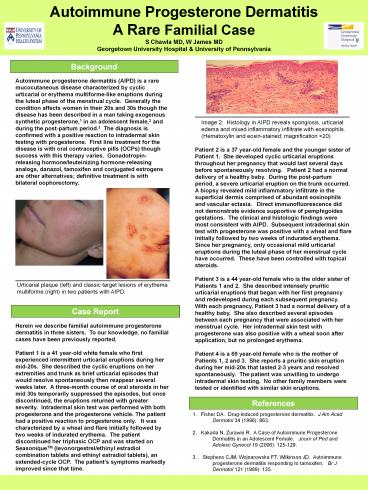Style A 36 by 48 tall - PowerPoint PPT Presentation
1 / 1
Title:
Style A 36 by 48 tall
Description:
Patient 2 is a 37 year-old female and the younger sister of Patient 1. She ... Patient 3 is a 44 year-old female who is the older sister of Patients 1 and 2. ... – PowerPoint PPT presentation
Number of Views:81
Avg rating:3.0/5.0
Title: Style A 36 by 48 tall
1
Autoimmune Progesterone Dermatitis A Rare
Familial Case S Chawla MD, W James MD Georgetown
University Hospital University of Pennsylvania
Background
Autoimmune progesterone dermatitis (AIPD) is a
rare mucocutaneous disease characterized by
cyclic urticarial or erythema multiforme-like
eruptions during the luteal phase of the
menstrual cycle. Generally the condition affects
women in their 20s and 30s though the disease has
been described in a man taking exogenous
synthetic progesterone,1 in an adolescent
female,2 and during the post-partum period.3 The
diagnosis is confirmed with a positive reaction
to intradermal skin testing with progesterone.
First line treatment for the disease is with oral
contraceptive pills (OCPs) though success with
this therapy varies. Gonadotropin-releasing
hormone/leuteinizing hormone-releasing analogs,
danazol, tamoxifen and conjugated estrogens are
other alternatives definitive treatment is with
bilateral oophorectomy. _____________
____________________________________ Urticarial
plaque (left) and classic target lesions of
erythema multiforme (right) in two patients
with AIPD. Herein we describe familial
autoimmune progesterone dermatitis in three
sisters. To our knowledge, no familial cases
have been previously reported. Patient 1 is a
41 year-old white female who first experienced
intermittent urticarial eruptions during her
mid-20s. She described the cyclic eruptions on
her extremities and trunk as brief urticarial
episodes that would resolve spontaneously then
reappear several weeks later. A three-month
course of oral steroids in her mid 30s
temporarily suppressed the episodes, but once
discontinued, the eruptions returned with greater
severity. Intradermal skin test was performed
with both progesterone and the progesterone
vehicle. The patient had a positive reaction to
progesterone only. It was characterized by a
wheal and flare initially followed by two weeks
of indurated erythema. The patient discontinued
her triphasic OCP and was started on SeasoniqueTM
(levonorgestrel/ethinyl estradiol combination
tablets and ethinyl estradiol tablets), an
extended-cycle OCP. The patients symptoms
markedly improved since that time.
_________________________________________________
Image 2 Histology in AIPD reveals
spongiosis, urticarial edema and mixed
inflammatory infiltrate with eosinophils.
(Hematoxylin and eosin-stained magnification
20) Patient 2 is a 37 year-old female and the
younger sister of Patient 1. She developed
cyclic urticarial eruptions throughout her
pregnancy that would last several days before
spontaneously resolving. Patient 2 had a normal
delivery of a healthy baby. During the
post-partum period, a severe urticarial eruption
on the trunk occurred. A biopsy revealed mild
inflammatory infiltrate in the superficial dermis
comprised of abundant eosinophils and vascular
ectasia. Direct immunofluorescence did not
demonstrate evidence supportive of pemphigoides
gestations. The clinical and histologic findings
were most consistent with AIPD. Subsequent
intradermal skin test with progesterone was
positive with a wheal and flare initially
followed by two weeks of indurated erythema.
Since her pregnancy, only occasional mild
urticarial eruptions during the luteal phase of
her menstrual cycle have occurred. These have
been controlled with topical steroids. Patient 3
is a 44 year-old female who is the older sister
of Patients 1 and 2. She described intensely
pruritic urticarial eruptions that began with her
first pregnancy and redeveloped during each
subsequent pregnancy. With each pregnancy,
Patient 3 had a normal delivery of a healthy
baby. She also described several episodes
between each pregnancy that were associated with
her menstrual cycle. Her intradermal skin test
with progesterone was also positive with a wheal
soon after application, but no prolonged
erythema. Patient 4 is a 69 year-old female who
is the mother of Patients 1, 2 and 3. She
reports a pruritic skin eruption during her
mid-20s that lasted 2-3 years and resolved
spontaneously. The patient was unwilling to
undergo intradermal skin testing. No other
family members were tested or identified with
similar skin eruptions.
Case Report
References
- Fisher DA. Drug-induced progesterone dermatitis.
J Am Acad - Dermatol 34 (1996) 863.
- Kakarla N, Zurawin R. A Case of Autoimmune
Progesterone - Dermatitis in an Adolescent Female.
Journ of Ped and - Adolesc Gynecol 19 (2006) 125-129.
- 3. Stephens CJM, Wojnarowska FT, Wilkinson JD.
Autoimmune - progesterone dermatitis responding
to tamoxifen. Br J - Dermatol 121 (1989) 135.































